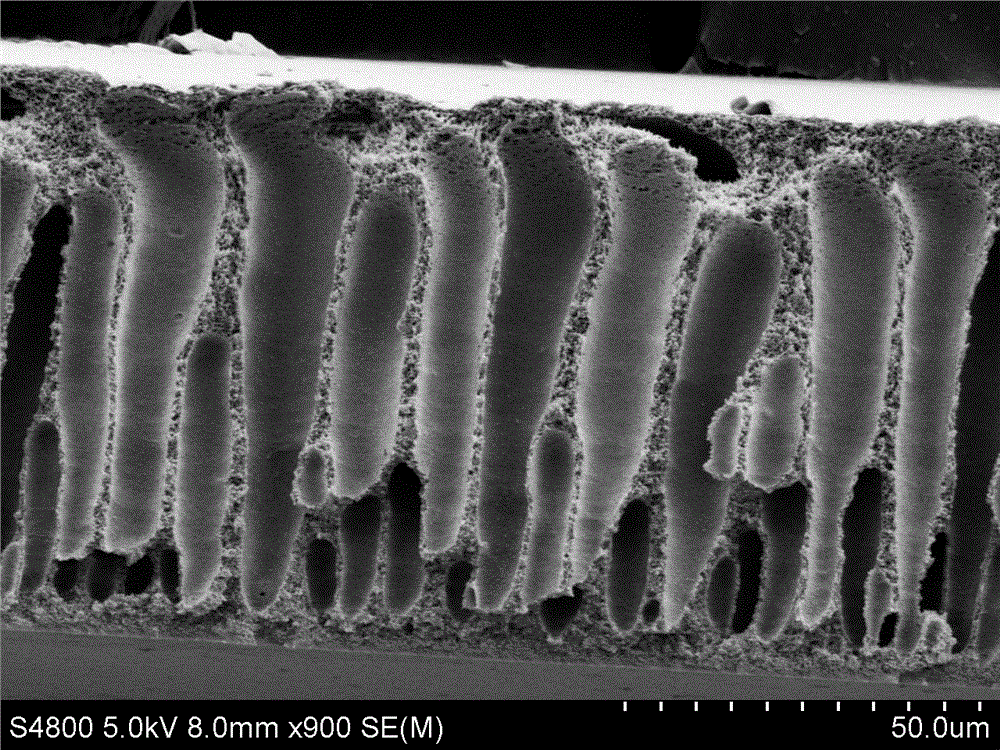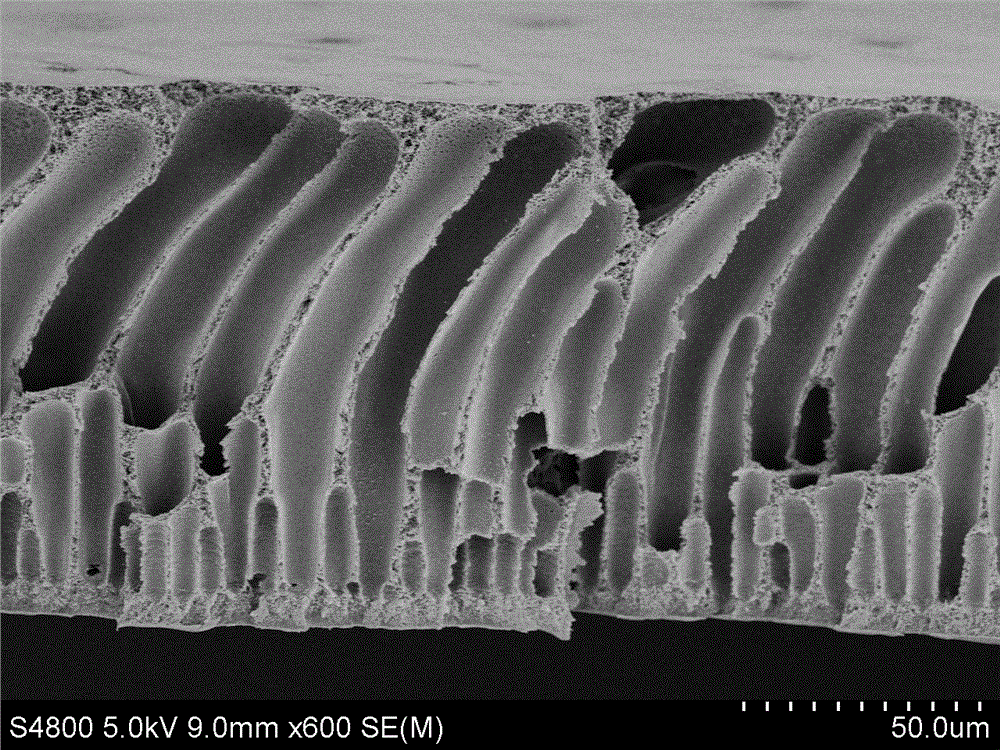A kind of asymmetric polyimide membrane for separating methylcyclopentadiene and cyclopentadiene
A technology of methylcyclopentadiene and polyimide membrane, which is applied in the fields of semi-permeable membrane separation, membrane purification/separation, membrane technology, etc. It can solve complex vacuum distillation process, complex process flow and high equipment requirements. problems, to achieve the effect of good selective permeability, high separation rate and simple equipment
- Summary
- Abstract
- Description
- Claims
- Application Information
AI Technical Summary
Problems solved by technology
Method used
Image
Examples
Embodiment 1
[0034] Dissolve an appropriate amount of dried 4,4-diaminodiphenyl ether (ODA) in N,N-dimethylacetamide (DMAc), stir to fully dissolve the ODA, and add an appropriate amount of bisphenol-A diether in three batches Dianhydride (BPADA), N 2Stir under protection, slowly add equimolar equivalents of acetic anhydride and triethylamine dropwise, and raise the temperature to 60°C for chemical imidization, then quickly pour the mixture into stirring ethanol to precipitate a polymer, wash with deionized water Afterwards, place in a vacuum oven to prepare polyimide solids.
[0035] The above-mentioned polyimide solid is dissolved in N-methylpyrrolidone (NMP) according to a certain mass ratio, N 2 Add acetone with a mass ratio of 15% under protection, oscillate to dissolve, filter the casting film solution through stainless steel wire mesh to remove impurities, let it stand for degassing, then evenly drool on the glass plate, control the volatilization time of different solvents, scrape...
Embodiment 2
[0039] Take the polyimide solids prepared by different amounts of example 1 according to the polyimide solid content as 16%, 17%, 18%, and 20%, and dissolve them in N-methylpyrrolidone (NMP), N 2 Add acetone with a mass ratio of 15% under protection, oscillate to dissolve, filter the casting film solution through stainless steel wire mesh to remove impurities, let it stand to remove air bubbles, and evenly drool on a glass plate. The solvent volatilization time is 60s, scrape to form a film, and place Precipitate in a deionized hydrogel bath at 20°C, soak in deionized water and glycerol to replace the solvent, prepare polyimide asymmetric membranes with different solid contents, and use a membrane pervaporation performance evaluation device to measure its separation performance. Liquid is C 5 Fractional distillation product (mass ratio of methylcyclopentadiene to cyclopentadiene after thermal depolymerization is about 80:20), through which the material is analyzed and composed...
Embodiment 3
[0043] Take by weighing the polyimide solid prepared by an appropriate amount of example one, dissolve in N-methylpyrrolidone (NMP), N 2 Add acetone with a mass ratio of 15% under protection, oscillate to dissolve, filter the casting film solution through stainless steel wire mesh to remove impurities, let it stand to remove air bubbles, and evenly drool on a glass plate. The solvent volatilization time is 60s, scrape to form a film, and place Phase inversion precipitation in different gel media at 20°C, soaked in deionized water and glycerol to replace the solvent, prepared polyimide asymmetric membranes formed under different gel media conditions, and measured their properties using a membrane pervaporation performance evaluation device Separation performance, feed liquid is C 5 Fractional distillation product (mass ratio of methylcyclopentadiene to cyclopentadiene after thermal depolymerization is about 80:20), through which the material is analyzed and composed by gas chro...
PUM
| Property | Measurement | Unit |
|---|---|---|
| thickness | aaaaa | aaaaa |
| thickness | aaaaa | aaaaa |
| separation factor | aaaaa | aaaaa |
Abstract
Description
Claims
Application Information
 Login to View More
Login to View More - Generate Ideas
- Intellectual Property
- Life Sciences
- Materials
- Tech Scout
- Unparalleled Data Quality
- Higher Quality Content
- 60% Fewer Hallucinations
Browse by: Latest US Patents, China's latest patents, Technical Efficacy Thesaurus, Application Domain, Technology Topic, Popular Technical Reports.
© 2025 PatSnap. All rights reserved.Legal|Privacy policy|Modern Slavery Act Transparency Statement|Sitemap|About US| Contact US: help@patsnap.com



